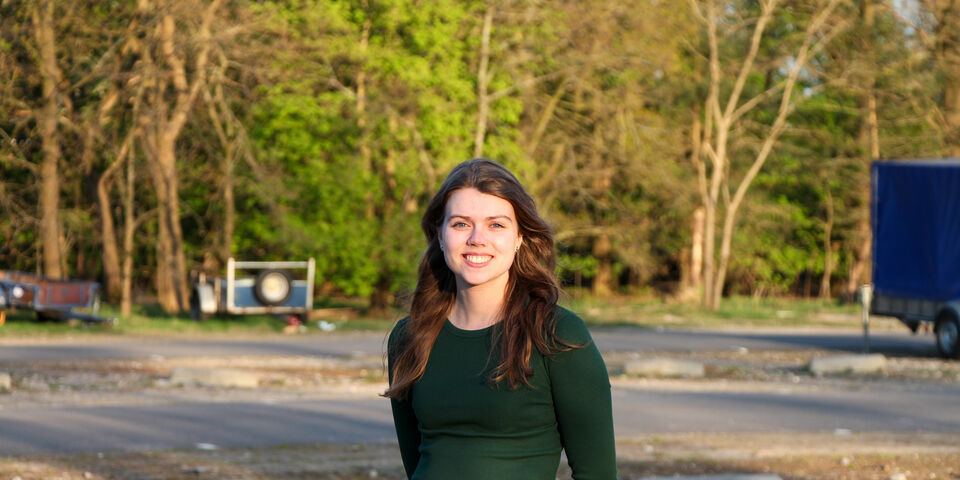We don’t have a parking problem, but a convenience problem
After reading Cursor’s article Parking on campus becomes a problem after 9 AM, Anne-Sophie Borgers wondered why we have come to see the convenience of cars as a right. The complaints about the so-called parking problem on campus came as a surprise to the master’s student and team manager of GO Green Office, and she thinks this issue could be looked at from a different perspective.
Since August of last year, I’ve been living on campus, in the new Haven complex. Therefore, the greater part of my day takes place on university grounds. So I find it interesting to see what happens to all those parking spaces at night or on the weekends: absolutely nothing. Parking lots are mostly deserted then, leaving behind a vast expanse of stone. That’s when it feels particularly wasteful that this mode of transportation takes up so much space for such a small amount of time. Imagine what else that space could have been: more greenery, more biodiversity, places to relax, or room for TU/e’s latest facilities.
Cursor writes about the parking pressure on campus as if it’s an inescapable burden that needs to be alleviated as soon as possible. But I think it’s time that we, as a university – and as a society, really – change the way we look at cars. Perhaps we should move away from end-of-pipe solutions (like constantly adding more parking spaces) and start thinking in terms of a systems transition with smarter solutions to mobility challenges instead of uninspired parking garages.
Taken for granted
A car comes with a lot of convenience; and we as a society have become quite accustomed to that. A car takes you wherever you want to go, from door to door. But that convenience has become so taken for granted that having to park more than a five-minute walk away from your workplace is already considered too inconvenient.
What surprises me is that people talk of a shortage of parking spaces, when there are several areas where there is still plenty of room. The wind tunnel and the MMS site have already been mentioned, but the parking lot next to the Pollux residential tower and the spaces just beyond Fenix are also not popular. Still, convenience seems to take precedence, and people prefer to double park or ask for a new parking garage.
But how does a parking garage fix this problem? Apparently, it would have to be located at the very center of campus to count as a solution, because a garage on the edge of campus grounds is already “too far away”. In my opinion, it’s actually a good thing that the taken-for-granted convenience of having your car parked right outside the door is being challenged.
Smarter choices
I think some consideration should also be given to the location of our campus, and how it differs from the High Tech Campus and its many parking garages. We are fortunate that our campus is located right in the middle of the city. That comes with certain advantages: excellent public transport connections, within walking distance of the train station and the city center, situated in a dynamic urban environment with lots of greenery and nature, and space for relaxation.
Moreover, Eindhoven is growing rapidly. With KnoopXL on the way, the area around the campus will become even busier, and with the upcoming expansion of the zero-emission zone, we’re facing new challenges. Instead of clinging to old patterns, we should think about future-oriented solutions. We need to work together with the region to improve public transport accessibility, provide safe and efficient cycle routes and “last mile” solutions, for the final stretch to the destination that public transport or cars can’t reach. That automatically makes public transport or (electric) bicycles a suitable alternative for the car without turning the campus into a sea of metal and asphalt.
So should we broaden our perspective at TU/e? I think so. Develop a commuting policy that fully reimburses public transport costs. Perhaps there are also smart opportunities to be found in the use of residential areas surrounding the campus. We could use the vacant parking spaces of the (future) residential towers surrounding the campus during the day, and at night, the usage is reversed and residents can park on the TU/e campus. Doesn’t that present an opportunity to make double use of limited space?
Personal interest or collective interest
And shouldn’t we ask ourselves if putting up with a few extra minutes of travel time for a more sustainable and healthier campus is really that bad? Or does the convenience of getting to park your car right next to your workplace outweigh the collective interest of a safe, green, and healthy campus?
And sure, my vision might mean a ten-minute walk from the car to your workplace. But let’s please stop pouring money into more tiles and asphalt and keep thinking in terms of innovative solutions. That will require a little more understanding from everyone about the situation and the “inconvenience” of a healthy walk. I say: a healthy campus starts with a healthy distance from your car.
Anne-Sophie Borgers is a master’s student in Innovation Sciences and Team Manager at GO Green Office. She wrote this column in a personal capacity.


Discussion